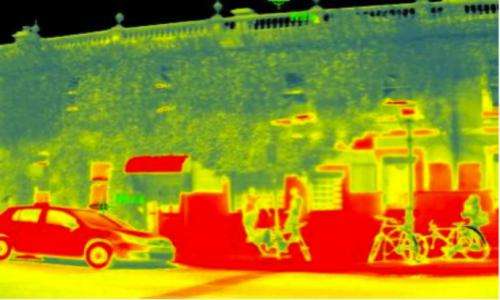Plants help lower temperatures

(Phys.org)—As Melbourne swelters through another heat wave, scientists are using thermal imaging to work out how plants can be used to reduce the severe temperatures in our cities.
Because cities are covered in heat absorbing, hard surfaces such as concrete and bitumen they absorb and store heat, making urban areas warmer than the surrounding countryside, especially at night.
Temperatures can be as much as 4 degrees warmer in the city of Melbourne than surrounding areas - this is known as the 'urban heat island effect'. And on rainy days these hard, non-porous surfaces also prevent water being absorbed into the ground so that little moisture remains in the urban environment.
A team of University of Melbourne and Monash University researchers is trying to establish how street trees, parks, green roofs and green facades (collectively known as green infrastructure) can interact with urban design to reduce temperatures in cities.
Their results show that leafy, green streets and irrigated open space areas were much cooler than built up urban areas without green infrastructure.
Researchers have used thermal imaging and mobile weather stations during summer extreme heat events to identify some of Melbourne's 'hot spots' and compare these with temperatures from areas with abundant green infrastructure such as Royal Park.
This information will now be used to produce a guide with collaborators at RMIT, to demonstrate which types of green infrastructure should be installed on streets with different orientations, widths and building heights to best reduce surface temperatures.
University of Melbourne researcher Dr Nick Williams said higher temperatures in cities were a huge concern for society, particularly vulnerable members such as the elderly, and will only increase with climate change.
"Plants are attractive, natural air conditioners so we should be using them more to cool cities. As well as providing shade, plants also cool cities by evaporating water through their leaves into the atmosphere," said Dr Williams, from the Melbourne School of Land and Environment at the University of Melbourne.
"Irrigating green infrastructure with the abundant storm water found in our cities will increase its cooling ability and use water that would otherwise go down the drain."
Monash University's Dr Andrew Coutts said while the research demonstrated the benefits of increasing green infrastructure, not enough is known about what would work best in Australian cities, or how best to design green infrastructure into urban areas.
By using airborne thermal mapping and combining it with on-ground measurements, we can produce a good spatial picture of surface temperatures across the urban landscape. This will allow us to assess which areas are cooler than others and how vegetation might be helping," he said.
"The final step is to look at what features of urban greening work best to reduce heat in urban Melbourne."
It is hoped this research will show the importance of including green infrastructure in urban developments, and help guide planning in terms of the distribution, abundance and types of urban greening needed.
Provided by University of Melbourne

















